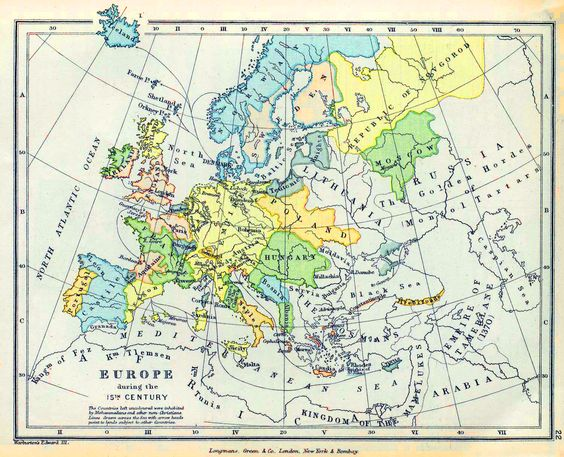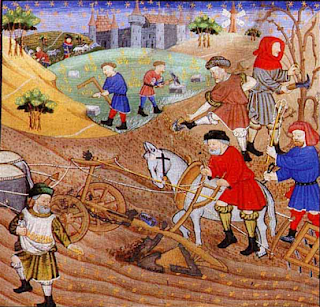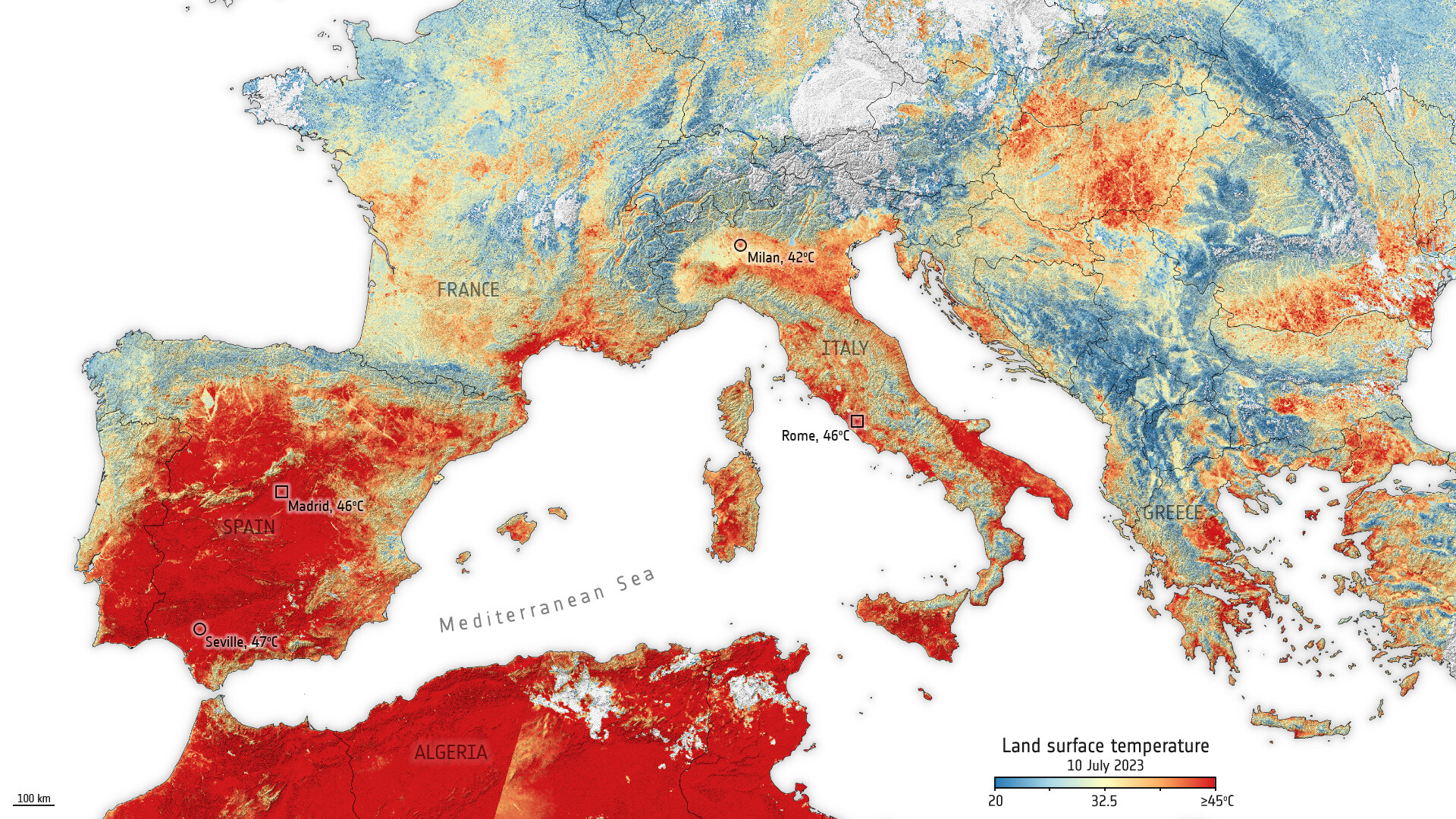
Reconstructing global temperature variations over the last millennium is a challenge taken up by dozens of teams of climatologists around the world. There are two main reasons for this: to understand how the climate system has reacted to solar variations and volcanic eruptions over the last 1,000 years, and to place global warming since the beginning of the 20th century in a multi-century perspective.
Few reliable temperature measurements existed before the 20th century (and none before the invention of the thermometer around 1650). Historical, biological, physical and geochemical climate indicators (or proxies) are combined to produce a set of reconstructions for the last millennium, from regional to hemispheric scales.
These temperature reconstructions highlight multi-century warm phases in the Northern Hemisphere during the Middle Ages (the Medieval Climate Optimum, from 1000 to 1450), contrasting with colder periods (the Little Ice Age, from 1450 to 1800). The chronicles collected by historians also bear witness, over these two periods, to extreme events (heat waves, cold waves or storms) that had disastrous consequences for societies.

As with temperatures, there are no direct measurements of variations in solar and volcanic activity over the past centuries. For the Sun, an estimate is obtained via the cosmogenic isotopes 10Be or 14C present in polar ice and tree rings, whose production depends on the Sun’s activity. Volcanic eruptions, on the other hand, are deduced from sulfur layers observed in Greenland and Antarctic ice cores.
To understand the relationships between changes in mean temperature, the occurrence of climate extremes and natural climate forcings over the last millennium, scientists have set up numerical climate experiments. Simulations were run with several amplitude scenarios for solar and volcanic forcings to estimate the uncertainty associated with disturbances and their responses.
An important result suggests that the amplitude of solar forcing variations that need to be introduced into models to correctly reproduce the alternation of the Medieval Optimum and the Little Ice Age must be twice as large as the best observational estimates. Two hypotheses have been put forward to explain this discrepancy: the representation of solar forcing in climate models is too imperfect, or internal climate variability has played a major role. The main player on these timescales is the North Atlantic Ocean overturning circulation, which brings large quantities of heat to high latitudes, and which may have its own centennial to millennial variability. Because of its great inertia and very large-scale structure, it could explain a significant proportion of the variations observed over the last millennium.
In addition, it has been shown that tropical volcanic eruptions inject dust and sulfur into the upper atmosphere, which, via the parasol effect, have affected the global climate for around ten years for the most intense events of the last millennium.
Note:
WEATHER IN HISTORY 1400 TO 1499 AD
(T: warm/cold events; R: dry/wet events; S: ‘stormy’ events)
| Date | T | R | S | Description | Ref: |
| 1400-1409 (First decade, 15th C) | Summers possibly frequently / anomalously WET. [Lamb & others] | x | |||
| 1400-1449 | According to Gottschalk (1971), the number of storm surges to affect the southern North Sea during this half-century was identified as 9; this compares with 7 for 1350-1399, 4 each for 1250-1299 & 1300-1349 and 3 in the period 1200-1249. Probably coupled to the changes as the European climate cooled. [ quoted in reference; however note that HH Lamb also was aware of Gottschalk’s work, and interpreted the figures somewhat differently, for example, in his diagram p.183 of Reference 1, he has the 13th century as experiencing BY FAR the greater number of severe storm floods (14 to 15) along the coasts of the North Sea and the English Channel, with the 15th century (this one), just 4; later workers have used Gottschalk’s figures and perhaps more information is available to them than Professor Lamb was aware of. ] | 1, 25 | |||
| 1404 (November) | Major storm surge event affects North Sea around November 19th (OSP); not clear if this also affected English coasts, but given the dramatic impact on the Netherlands (where it was known as the ‘First Elisabeth flood’), it would be remarkable if it hadn’t. [See also 1421 & 1424.] | 25, GOTT | |||
| 1407/08 (Winter) | The severe winter affected most of Europe, and is regarded by climatologists as one of the most severe on record. The frost lasted for 15 weeks and people were able to walk across the frozen Thames. According to Ian Currie (a noted authority on historical weather events), “one of the most snowy & was of outstanding duration”. [ In Europe, ice in the Baltic had allowed traffic between the Scandinavian nations, and wolves had passed over the ice from Norway to Denmark.] | 8, usw | |||
| 1410s (Decade) | After the frequently wet summers of the first decade, modern researchers believe that the second decade of the 15th Century was often dry or very dry. [Lamb & others] | x | |||
| 1410 | In this year, the tidal River Thames froze over for 14 weeks. (I think, given the length mentioned, that we have to assign this to winter 1409/10) | x | |||
| 1413 (April) | Henry V crowned at Westminster Abbey on April 9th (OS); the ceremony was marked by a very bad snow storm, but people were unable to decide if this was a bad omen or a good one. [ This may not too significant at this time, as we are approaching one of two ‘troughs’ in the “Little Ice Age”.] | 8, TREF | |||
| 1413 (August) | 10th August 1413 (OS)/19th August (NS): southerly storm of blown sand which obliterated the medieval town of Forvie on the east coast of Scotland north of Aberdeen. Apparently there would have been an historically ‘unusually extreme low tide’ which would tie in with the event; notwithstanding this comment, Lamb has reservations about the date, but not of course the event. There was also, apparently, a ‘stormy’ period on this coast in the period 1401 to 1404, and therefore the 1413 storm may simply have been ‘one storm too many’! | 23 | |||
| October 1415 | Battle of Agincourt (NE France): on the eve of the battle, heavy rain fell and the battleground became water-logged & sodden – this impeded the forces opposing Henry V (particularly those more heavily armoured). Implies that the weather must have been wet for some time before. | sev. | |||
| 1421 | Notable storms / coast flooding North Sea region. >March 2nd (OSP), but some have January 15! – significant storm/flood. > November 18th (but variously listed as 17th to 19th different sources/OSP), 1421, the south-western part of Holland (where known as the ‘Second Elisabeth flood’ after the feast day around this time) was inundated: 72 villages were destroyed, 10000 people drowned. (Given the proximity to the English SE coast, this event must have had some impact here.) [ see also 1404 & 1424] | 1, 7, 25, GOTT | |||
| 1422/1423 (Winter) | A severe winter in western Europe / implies parts of Britain. (Easton, in CHMW/Lamb) | 1 | |||
| 1423 | A wet year. (London/South) | 8 | |||
| 1424 (November) | November 18th (OSP) – in the Netherlands known as the ‘Third Elisabeth flood’; known there as … “greatest disaster of the 15th century and perhaps the greatest of the second half of the Middle Ages (in Holland).” [ See also 1404 and 1421 ] | GOTT | |||
| 1426 | A dry year. (London/South) | 8 | |||
| 1428 | A wet year. (London/South) | 8 | |||
| 1430’s | Majority of winters, [ perhaps 7 or 8 ] contained several weeks of widespread severe weather (NB: ‘weeks’, not the paltry ‘days’ we get end 20th / early 21st centuries.) According to Lamb, an experience not repeated / matched until the 1690’s, in the depth of the Little Ice Age (and certainly not in modern times). | 1 | |||
| 1431/1432 (Winter) | A cold (possibly severe) winter in western Europe / implied parts of Britain. (Easton, in CHMW/Lamb) | 1 | |||
| 1434/35 (may be 1433/34**) (Winter) | A severe winter, perhaps one of the most severe in the last millennium. (Easton, in CHMW/Lamb); In this winter, the Thames was frozen from below London Bridge to Gravesend. Sea-borne goods were landed at the mouth of the river and taken over the ice into London. A frost (however defined) from the latter part of November to (at least) St. Valentine’s Day (14th February); probably at least England, but may apply to a wider area of Britain. (‘Weather’/RMetS/May 2011) [** and it is possible that there were two consecutive winters involved, i.e., 1433-34 and 1434-35. Certainly there are reports of ‘intense frost’ in Scotland in the winter of 1435 & a note that the Thames was frozen sufficient to bear waggons in the same year.] | 1, 8 | |||
| 1437 (December) | Either early December or perhaps around 15th November; considerable doubt about dating. Storm/flood affects coastal Holland – possibly coastal England. | GOTT | |||
| 1438 (November) | Gale on 23rd November did much damage in London. | 8 | |||
| 1439 | A wet year. | 8 | |||
| 1442/1443 (Winter) | A cold winter western Europe / implied parts of Britain. (Easton, in CHMW/Lamb) | 1 | |||
| 1st February 1444 | St. Paul’s cathedral was struck by lightning and the steeple was set on fire. (see also 1561) | 8 | |||
| 1445 (March) | Margaret (of Anjou) [ future Queen-Consort to Henry VI ] crossed the Channel in March 1445 – in horrendous weather; She crossed from Cherbourg to Portsmouth – as they approached the English coast, a storm blew up (probably a thunderstorm associated with a rapidly developing area of low pressure), and the ship wallowed in ‘mountainous seas’. The ship was guided with much difficulty through the Needles Channel to run before the SW wind towards Portsmouth, but the ship was dis-masted and it was beached near Porchester. The storm (i.e. the main area of low pressure) continued for several days, uprooting trees, killing cattle in the fields, causing rivers to overflow and flood low-lying ground. Much damage to roofs and deaths were reported. | x | |||
| 1446 | Notable storms / coast flooding this year in the North Sea region (Lamb): In April, 1446 (?10th OSP) in particular, a North Sea storm occurred coupled with a significant tidal surge. “Thousands” died in coastal areas of the North Sea. | 1, GOTT | |||
| 1448 | Thames flooded Poplar, Stepney and other placed during March. Not known if this is due to a storm-surge or heavy rain (or a combination of both). | 8 | |||
| 1449 (October) | Possible major Storm/flood affected the Dutch coast – possibly also the English coastline. Month given as October & around the middle of the month. | GOTT | |||
| 1457/1458 (Winter) | A cold winter in western Europe / implied parts of Britain. (Easton, in CHMW/Lamb) | 1 | |||
| 1459 | “The river Liffey at Dublin was entirely dry for the space of two minutes” [ this implies a great drought for at least 12 months, perhaps longer.] (Annals of Dublin/www.chaptersofdublin.com) | op.cit. | |||
| 1460 | The wet summer was claimed to be one of the worst for 100 years. | 8 | |||
| 1461 | There is mention of a ‘great tempest’ destroying the east window of Christ-church, Dublin – causing damage inside the cathedral. It is difficult to be sure whether this was just a ‘local’ storm, or something of a wider nature. [ From the ‘Annals of Dublin’ / www.chaptersofdublin.com ] | op.cit. | |||
| 1464/1465 (Winter) | A cold winter over western Europe / implied parts of Britain. (Easton, in CHMW/Lamb) [ The following text (from research into Irish writings) may relate to this winter & subsequent spring . . . ” Exceeding great frost and snow and stormy weather this year, so that no herb grew in the ground and no leaf budded on a tree until the feast of St. Brendan, but a man, if he were the stronger, would forcibly carry away the food from the priest in church, even though he had the Sacred Body in his hands and stood clothed in Mass-vestments. Feast of St. Brendan: 16 May, Julian Calendar, or 25 May, Gregorian Calendar in 1465 CE. Source: Annals of Connacht, 1465 CE. Source: http://iopscience.iop.org/1748-9326/8/2/024035/article ] | 1, (see text) | |||
| 1468 (October) | October 20th/21st (OSP); Storm/flood – in the Netherlands known as the ‘Ursula flood’; perhaps affecting English coastal communities. | GOTT | |||
| 1473-1479 | Droughts with very hot summers occurred in the three successive years 1473-1475; assumed to be applicable to South/Central England only. (In the period 1473-1479, there were 5 fine summers in this seven year period: 1473, 1474, 1475, 1477 & 1479). | 8 | |||
| 1477 (September) | Flood/storm affecting large areas of coastal Belgium, Germany & the Netherlands: known as the ‘first Cosmas and Damianus flood’ in at least Holland; dated 27th (OSP). | GOTT | |||
| 1480/1481 (Winter) | A cold winter in western Europe / implied parts of Britain. (Easton, in CHMW/Lamb) | 1 | |||
| 1483 (October) | An extraordinary flood of the Severn (near Worcester) in October prevents the Duke of Buckingham from crossing to attack Richard III, the duke’s army disperses, and he is taken and beheaded. | (var) | |||
| 1485 | |||||
| 1488 | Great snow & frost (where, when ??) | 8 | |||
| 1490 | Drought (London/South). | 8 | |||
| 1498 | A dry year (in London/South) | 8 |
https://premium.weatherweb.net/weather-in-history-1400-to-1499-ad
https://en.wikipedia.org/wiki/Medieval_Warm_Period
https://en.wikipedia.org/wiki/1540_European_drought




